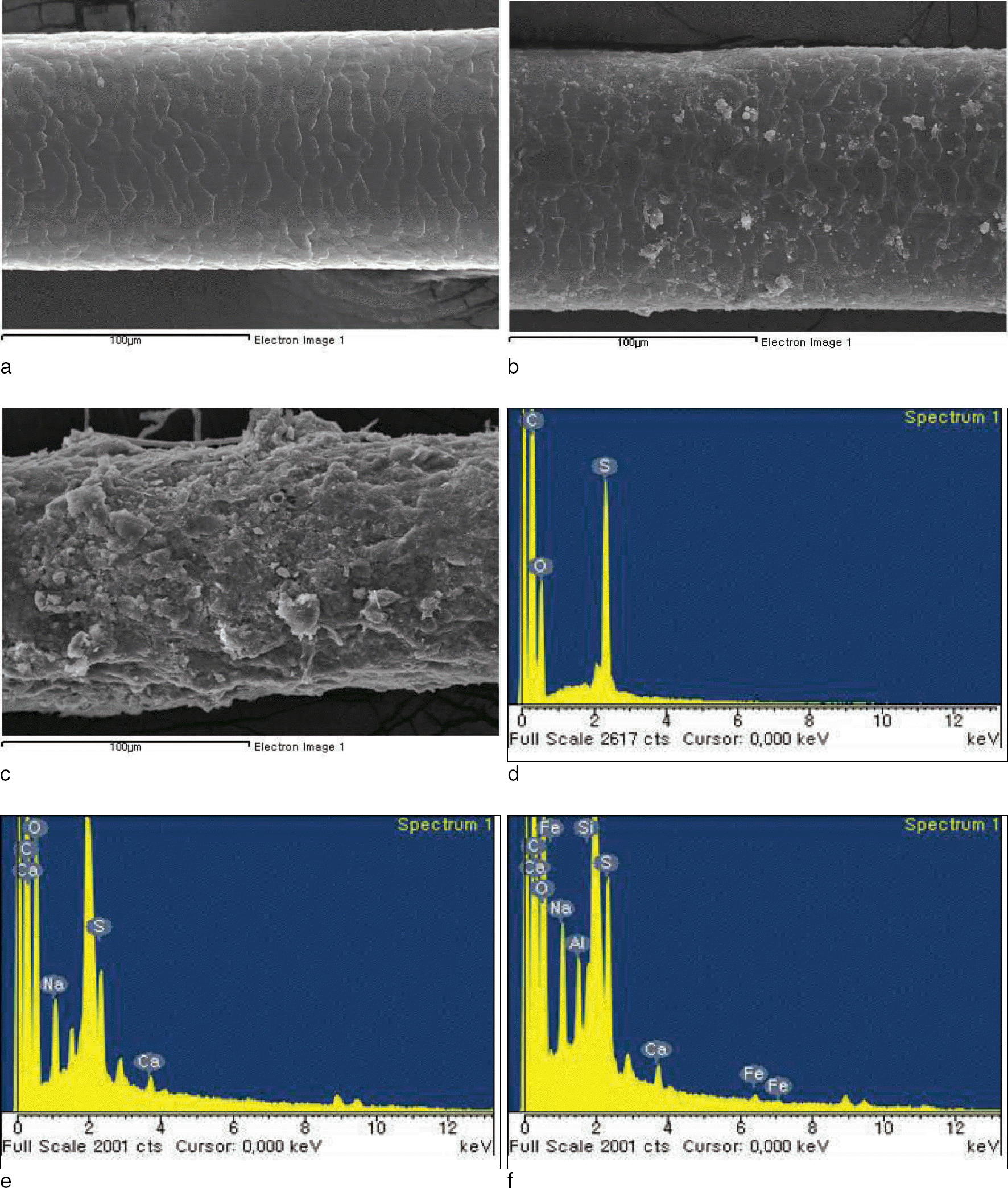Abstract
This study was undertaken to investigate mineral changes in weathered scalp hair after burial. EDX (energy dispersive X-ray spectroscopy) analysis was performed to measure the presence of minerals on the hair surface. Twelve scalp hairs, buried for 5-40 years, were chosen from deceased individuals buried in tombs in Soha-Ri, Kyonggi-Do, and other regions in Korea. Three normal hairs were used as the control group. EDX data showed that carbon, oxygen, and sulfur were detected in hair collected from all three burial grounds. In contrast, calcium was only detected in hair collected from tombs in Soha-ri. The amounts of calcium and sulfur were found to decrease with time for hair collected from tombs in Soha-ri. Similar results were observed with sodium for hair collected from other regions. These results show region specific mineral detection and a decrease in the concentration of minerals with time. Consequently, it is suggested that changes in minerals concentration in weathered hair could be used as basic data in the field of forensic medicine.
Go to : 
REFERENCES
1. Amory S, Keyser-Tracqui C, Crubezy E, et al. Multi-sub-strata analysis on Siberian mummies: a different way for validation in ancient DNA Studies? Int Congr Ser. 2006; 1288:834–6.

2. Daniel CR 3rd, Piraccini BM, Tosti A. The nail and hair in forensic science. J Am Acad Dermatol. 2004; 50:258–61.

3. Wilson AS, Dixon RA, Dodson HI, et al. Yesterday’ s hair-human hair in archaeology. Biologist (London). 2001; 48:213–7.
4. Chang BS, Uhm CS, Park CH, et al. Ultramicroscopic study on the hair of newly found 15th century mummy in Daejeon, Korea. Ann Anat. 2006; 188:439–45.

5. Hwang KS, Nam YS, Kim JL, et al. TEM Observation on the weathering human scalp hair after burial. Korean J Phys Anthropol. 2012; 25:1–10.

6. Hwang KS, Lim DS, Ahn DC, et al. SEM observation on the weathering human hair after burial. Korean J Phys Anthropol. 2008; 21:181–90.

7. Ratnapandian S, Warner SB, Kamath YK. Photodegradation of human hair. J Cosmet Sci. 1998; 49:309–20.
8. Kempson IM, Skinner WM, Kirkbride PK, et al. Time-of-flight secondary ion mass spectrometry analysis of hair from archaeological remains. Eur J Mass Spectrom. 2003; 9:589–97.

9. Lee GY, Chang BS. Studies on the preservative condition and the ultrastructure of hair of newly found sixteenth century mummy in Paju. Korean J Electron Microscopy. 2005; 35:211–8.
10. Kempson IM, Skinner WM, Kirkbride PK. Calcium distributions in human hair by ToF-SIMS. Biochim Biophys Acta. 2003; 1624:1–5.

11. Dawber R, Comaish S. Scanning electron microscopy of normal and abnormal hair shafts. Arch Dermatol. 1970; 101:315–22.

12. Giehl KA, Ferguson DJ, Dawber RP, et al. Update on detection, morphology and fragility in pili annulati in three kindreds. J Eur Acad Dermatol Venereol. 2004; 18:654–8.

13. Venning VA, Dawber RP, Ferguson DJ, et al. Weathering of hair in trichothiodystrophy. Br J Dermatol. 1986; 114:591–5.

16. Scanavez C, Silveria M, Joekes I. Human hair: color changes caused by daily care damage on ultra-structure. Colloids Surf B Biointerfaces. 2003; 28:39–52.
Go to : 
 | Fig. 1.SEM images of the surface and typical EDX analysis spectra are shown. The morphological changes in weathering hair shafts are investigated by SEM (control hair (a), ≤ 10 years after burial (b) and ≥30 years after burial (c)). EDX to analyze the material found in the surface of the control hair (d), ≤ 10 years after burial (e) and ≥30 years after burial (f). C (Carbon), O (Oxygen), S (Sulfur), Na (Sodium), Ca (Calcium), Al (Aluminium) and Fe (iron). |
Table 1.
Classification of Hair Groups according to Duration of Burial
| Burial period (years) |
Area |
Total | Percentage (%) | |
|---|---|---|---|---|
| Soha-Ri | The others | |||
| ~10 | 1 | 1 | 2 | 15.4 |
| 11~20 | 2 | 2 | 4 | 30.8 |
| 21~30 | 2 | 1 | 3 | 23.0 |
|
31~40 |
1 |
2 |
3 |
23.0 |
|
Total |
6 |
6 |
12 |
100 |
Table 2.
Data of EDX of Hair according to Duration of Burial




 PDF
PDF ePub
ePub Citation
Citation Print
Print


 XML Download
XML Download